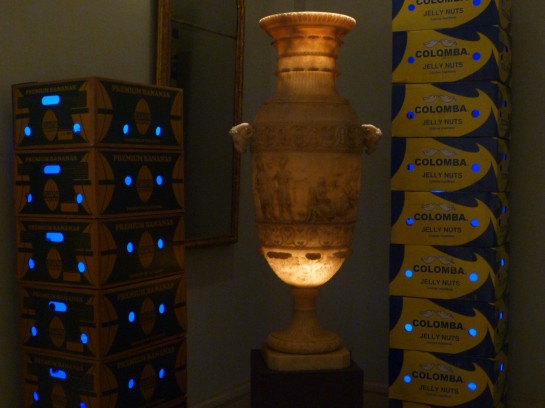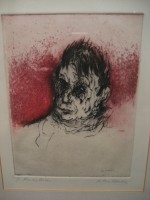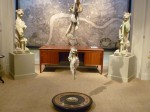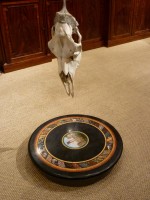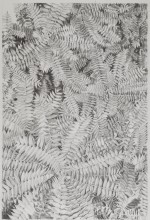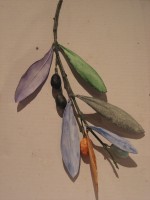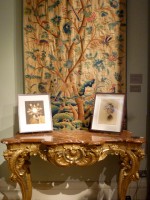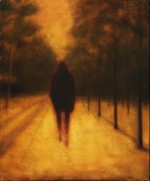Some of the works are still be available. Please contact the gallery if you have any enquiries.
Artists : Adam Barker-Mill, Paul Benney, Lucy Cavendish, Julie Cockburn, Milein Cosman, Emma Douglas, Babak Ghazi, Steven C. Harvey, Simon Heah, Hector Ramsay, Alannah Robins
Amongst the non-contemporary items will be the 'Arundel Table', an early-17th century sculptural object once part of the celebrated Arundel Marbles; a pair of stone heraldic leopards from one of the palaces of Henry VIII which are to be in a joint exhibition at the Kremlin Museum and the V. & A. later this year; a 17th century amber crucifix from the Palazzo Ducale, Modena; and a pair of massive Sevres vases made for Louis XVIII.
Organiser : Adrian Dannatt has been, at various times, an actor, editor, curator, writer and artist. He has organised exhibitions at venues ranging from Frank Lloyd Wright's Price Tower Arts Center in Oklahoma to Storefront for Art & Architecture, New York and Paul Kasmin Gallery. His own work has been exhibited at institutions as varied as the Whitworth Art Gallery and Deitch Projects in SoHo. For ten years he was New York columnist for The Art Newspaper.
OF GENEROSITY
Robert Louis Stevenson
For myself I love all the artists – might be my version of a rousing line in the table talk and recollections of Samuel Rogers where amongst heated debate on the varying merits and failings of sundry versifiers it is admitted that - for myself I love all the poets. And so it is. For if someone proclaims themselves to be a ‘poet’ or an ‘artist’ I must automatically give them the benefit of the doubt, yes, grant them my affection even merely for the courage of their calling. For these, for me, are the people who make life worth living, civilisation civilisation.
Of course, unlike the 18th century England of Samuel Rogers when the rules and regulations of poetry were highly maintained ( maybe more so than at any other period) today all sorts of things can be said to constitute ‘poetry’ and likewise ‘art’; in fact the majority of what is presented as poetry and art in our time would not be recognizable as such to a connoisseur of even one hundred years ago let alone three. This, of course, is completely natural as the purpose, meaning and practice of art is in a constant state of slow shift, the intention of the Byzantine Ikonist being as alien to that of the Georgian topographical watercolourist as the aims of the Belle Epoque salon Medallist are to the video installationist.
Thus to the 18th century expert not only would the majority of today’s art be clearly cack but they would be equally dismissive of huge swathes of what are now revered as the greatest masterpieces in our museums. How startling these previous ramifications of taste and the prejudices of every era, to try and imagine that once upon a time we happily dissed everything from Italian Primitives to Vermeer and Rembrandt, Rubens and Victorian narrative painting, let alone such things as Tribal sculpture or Islamic calligraphy. Thus to the favoured rallying cry of “it’s just not art” I am happy to proffer instead my hopeless love for each and every soi disant ‘artist’ regardless of their work and regarding instead their bravery in being such a thing.
Naturally I do not have to love their actual oeuvre in the way I do their calling, my instinctive warmth toward the person who is supposedly a poet or painter may well chill somewhat upon perusal of what they produce, and like every single one of us I have my own instinctive preferences and prejudices doubtless born out of some complex admixture of nature, nurture and experience. And even here it is curious to consider the changes in one’s own taste over the years, a penchant for Zulu war scenes somehow dovetailing into a passion for American Pop and back through Surrealism improbably into neo-classicism, proving, though one does not wish to believe it, that canons of taste are never definitive, least of all for oneself.
In most science fiction scenarios of the future a mono-culture is assumed to operate, everyone follows just one leader, everyone dresses a certain way, everyone uses a certain type of transport or worships a fixed single religion, everyone obeys Big Brother or wears zipped jumpsuits. Whereas, in reality the future would surely be as messy and diverse and complex as the everyday reality of contemporary life, no single way of being so dominant. Likewise any futurologist would doubtless determine that only one sort of art making would have become the accepted norm by, say, 2012, that everyone would universally make and enjoy a single style of visual culture fixed as the ‘art of our time.’ For what science fiction futurology seemingly cannot conceive is further and wider fracture and diversity rather than increased cohesion.
Thus in any SF vision of the 21st century one might be presented with a James Turrell light-room as the art of the era, but how hard to reconcile this abstract environment with the massed visitors amongst Lucian Freud’s portraits, including one of the reigning monarch no less, the most acclaimed and popular British artist of the same period. And how to understand the sheer range of cultural expression on display simultaneously just, for example, in the small square mile of St James’s where our current exhibition takes place, works ranging from commercial illustration to minimalism, graffiti tagging to flower studies, ceramics to video, trompe l’oeil to digital texting.
Some might claim that there is indeed an ‘official’ art of 2012, one supported by museums, curators and institutions rather than by popular mandate, and these might well be the same people who claim that ‘painting’ is out of favour, but the reality is, of course, far more nuanced, far richer. In truth, as any canny contemporary dealer will tell you, painting always remains the easiest and most profitable medium, and a close analysis of the statistics of even the most modish ‘cutting-edge’ galleries, yes some even in our same St James’s, would reveal that in fact a dominant percentage of work they show might be termed ‘painting.’
Likewise the exhibitions mounted by museums today are in reality, as opposed to assumption, hearsay or glib generalization, so varied and heterogeneous that it would be impossible to determine a dominant aesthetic. Figurative painting, whatever anyone claims to the contrary, has now been the most fashionable and favoured style amongst young and emerging and successful artists for more than a decade and currently a new wave of ‘abstract’ painting is much in vogue amongst the international jeunesse d’au jour d’hui. An impartial close analysis of the schedules of contemporary art museums, and even the prizes they award, might well actually reveal a surprising, a startling, lack of bias. Indeed the ‘conceptual’ art which is supported by institutions often exists only because of them. Some might claim that is precisely what is wrong, but surely one of the roles of such organizations is to back the difficult and marginal, work which cannot survive commercially as it tests even further the boundaries of art, not to mention our patience.
What I really love about the art world, art worlds, is just how much and many there are of them, that utterly extraordinary variety and impossible range of different practices and peoples of every conceivable nationality, income, title, background, abode and estate, all doing their own thing and just hoping it sticks in some way or another. I love equally the artists who give it all up and retire to Ladakh, the one’s who keep going with the pottery in the rural obscurity of the Welsh mountains, or gluing their collages in a hut on the Suffolk coast, the one’s who make a log in manic red ink of their daily walk from Harringay to Soho, who fill some parental ballroom with a giant romantic mural or display their unemployment benefit forms in a charted mathematical grid, who collect driftwood on heaths or teach perspective in Rome, all thus.
And what is truly inspiring in all this, the real magic, is that one simply cannot chart the vagaries of poverty and success, celebrity and obscurity, within this occult field. The fabled difficulty of art-as-investment-class-asset is precisely the slippery and unchartable nature of any such career, the movements of taste and money that back one figure and then another due to a vast range of often small factors, tiny shifts of thinking, miniature clues and cogs that eventually cohere to change the direction of art history. Even the most overtly successful of artists can see their career and prices slump in their own lifetime and likewise the most marginal and pitiful of figures can eventually find themselves fêted with full scale retrospectives and profiles. So often one thinks of Balthus in his Swiss domain, the largest, oldest and grandest chalet in all the land and his brother Pierre Klossowski who as an artist ended his days in a tiny apartment in a 1970s state housing block on the outskirts of Paris, and one surely thinks “Quel chic” as if this was the only way to outwit, to outsmart, to trump him.
I love the fact that a contemporary artist can be extremely poor and astonishingly wealthy, tremblingly grand and laughably destitute, and that somehow despite this they share to some extent the same world. Even at the most extreme degree of separation, a race horse portraitist in Saratoga and a concrete-poetry performer in Shanghai, there is bound to be, somewhere and through someone, a certain overlap, a wealthy mainland collector who knows them both, a vernissage to which both are invited through friends of friends, a publication or party that brings them together. They can dismiss out of hand the creative activities of each other, each can swear that neither is making ‘real art’, but they are both living and working within the art world and somehow hopefully surviving.
When it comes to ‘art’ we are aware that today absolutely any and every thing can constitute such an entity, that there are no definitions or limitations other than our own taste, that fact we are thankfully still allowed to cry “Pshaw, what absolute and blatant crap!” Of course we all enjoy criticizing and dismissing things, that is our very nature, but I can’t help suspect we currently put too much energy and ability into this essentially negative activity, rather than the harder art of celebration. I am instead for an openness, a laissez faire enthusiasm, a bold non-judgemental spirit of optimism which might have something of the genuinely radical implications of Christ’s doctrine of ‘love’ indeed. This is the mode whereby Andy Warhol operated, never saying a single negative thing about anything, reacting to everything he saw with a blank expression of intrigue, “Gee, wow, that’s really great.” Try it sometime, loving everything and everyone, and you’ll find it can be more effectively and enjoyably annoying, enraging, than any form of criticism.
When we encounter a work of art we have to remember that it exists because someone went through the labour of thinking it into being and ensuring it was created as they intended, it embodies some idea or ideals, dream or necessity, it is a part of that person whether it was made for money or made never to be shown, made for as myriad reasons as there are media and means. What we should do is just give it a little bit of attention, something it is often extremely hard to do. Having risked the portentous Jesus-thing I hardly dare push such pretensions further by recalling how Simone Weil described the act of prayer, that of actively giving one’s attention to someone else, as one of great difficulty and indeed it is not for nothing that people pay other people, psychoanalysts etcetera, just to actually listen to them.
Anyone who has been on a studio visit to an artist or indeed merely had to occasion to let them rip during some long drunken evening will have learnt that most artists simply long to be able to explain themselves and talk about their work, often the exclusion of anything else, often for hours. If they are lucky and reach a certain level of worldly success they will be amply granted this opportunity with devoted interviewers and TV crews and critics and historians hanging on their every word, but for many artists this chance comes all too rarely and their work is as easily ignored as those explications as to how and why it exists.
So we should give it that little moment of attention, we should look at it, walk round it, perhaps even prod it when nobody is looking, and wonder what exactly the artist wanted to express with this thing, what we take it to mean and what they intended it to mean, the history it comes from and the future it is trying to establish for itself, the aesthetic, intellectual, sensual or formal qualities it embodies. We should start by pretending that we like it, whatever it is, then taking it from there. We should try our best to see the best in it, for what do we lose by such generosity of spirit other than the bitter pleasure of superiority. The artist is inherently generous in giving us some part of themselves and we should be courteous enough, civilised enough, to give back generosity with generosity, to dare offer an open responsiveness that is the very enemy of irony. Thus to say, how should I put it, that I like everything, unless I don’t.
Adrian Dannatt
Walberswick-Paris-Le Coudray September 2012
